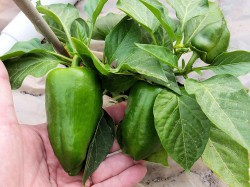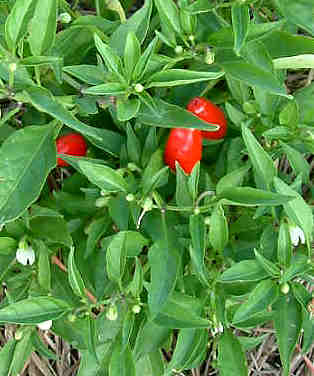Germinating Hot Pepper Seeds
Germinating hot pepper seeds is a little different from germinating sweet peppers, at least in my experience. And the more exotic the pepper, the more particular they may be about sprouting.
Here are some tips for growing hot chile peppers from seeds.
Peppers Like it Hot!
While you can coax sweet and bell peppers to germinate in a moderate soil of 70-75 degrees Fahrenheit, the chile peppers like their roots warmer…sometimes much warmer! In fact, some of the hottest of the peppers — like habanero, jolokia and scotch bonnet — prefer soil temperatures of 85 degrees or more before raising their little heads.
If you’re lucky enough to be gardening in a warm climate where the soil is already 80 degrees or more, you’ll likely be able to get the seeds to sprout. If you’re like the vast majority of us, those hot pepper seeds will need a little help. Even I need help in S. Florida during the winter and early spring!
Have They Spouted Yet?
Another trait hot peppers like jalapenos, cayenne, datil and more share is a long germination time. While sweet peppers can spring above ground within 7 to 10 days, hot peppers tend to take longer. Sometimes a lot longer!
I’ve found that most of my hot peppers sprout within a 12 to 18 day period. However, the very hottest can take up to a month (and boy, is the wait ever hard).
Help for Germinating Hot Pepper Seeds
Warmth is the biggest key in successfully germinating the chile pepper seeds. If you have a very warm spot in your home, like on a radiator, you may be good to go. For the rest of us, a seed germination mat is the best way to safely and gently warm the soil.
Something else I’ve found very useful, which surprised me in my trials, is using Terracycle. Terracycle is a gentle liquid fertilizer made from worm castings. After I moisten my seed-starting mix normally, I plant my seeds. After lightly covering my seeds with more soil mix, I spray Terracyle on the soil to dampen. Then, I give the soil a spritz every 2 or 3 days, to keep things moist.
Between the heat mat and the Terracycle, I’ve been able to shave time off the normal germination period, between 2 and 7 days. That may not sound like a lot earlier, but for anyone who’s (impatiently) waiting, any time saved is helpful.
One thing you don’t need for germination is light — seeds germinate fine in the dark. However, once the seeds have germinated, you’ll need to ensure the seedlings get 12 to 16 hours of light a day. A sunny windowsill is great, but I’ve also found that using fluorescent light bulbs works well (especially when I run out of space on my windowsills). 🙂
If you are looking for a seed germination mat, here are some for your consideration. Happy hot peppers!!!
How Long Do Pepper Plants Live?
How long do pepper plants live, anyway? Are they annuals, perennials or somewhere in between? Can you grow them indoors in the winter? Let’s take a look at the life of a pepper plant.
Note: In the years since I have written this post I have had more experiences with keeping pepper plants going — here’s my new post. (Read this one first, though, because it has additional information.)
Pepper Types (Species)
There are five main species of peppers:
- Capsicum annuum:Â Includes bell, sweet and many standard chile peppers like ancho, jalapeno, cayenne and more.
- Capsicum chinense:Â Includes datil, habanero and scotch bonnet peppers.
- Capsicum frutescens:Â Includes tabasco and thai peppers.
- Capsicum pubescens:Â Includes the South American rocoto peppers.
- Capsicum baccatum:Â Includes the aji peppers.
It’s important to know the species, as some are longer-lived than others. All pepper plants can be grown as annuals, but a few species can be perennial, provided they are in very warm, tropical climates.
There’s one pepper that seems to be cross-species, and that is the naga / bhut jolokia pepper. Originally called Capsicum frutescens, DNA testing has found some Capsicum chinense genes as well.
Capsicum Chinense as a Perennial
The Capsicum chinense peppers can live several years, providing they are in a warm climate. In theory, this means you can grow this species in a warm greenhouse as a perennial.
I’ve grown habaneros almost perennially here in South Florida, but I’m afraid that some of our cold snaps have done them in. This year I am trying habaneros and datils in containers, so that I can move them into the house (well, garage at any rate) when the temperatures fall below 45 degrees.
Capsicum Annuum
Your average pepper plant belonging to the species Capsicum annuum is generally grown as an annual. Although I have had some pretty long-lived jalapenos, they eventually get woody and die off.
I’ve never tried pruning a jalapeno, though, to see if I can revitalize it — that’s something I’ll have to try this year.
Although you really can’t grow them as a true perennial, Capsicum annuum can have an extended season. If you’re growing your pepper(s) in a container, you can try moving them indoors when the weather cools down. Just keep in mind that your pepper still needs plenty of sunlight; without sunlight, all the warmth in the world won’t extend your pepper’s life. That may mean a combination of south-facing window along with some supplemental light (grow lights).
Other Pepper Species
The same general rules apply to the other species; they need warmth and plenty of sunlight in order to keep growing. In their native tropical environments, the plants can live multiple years. But even in South Florida, they won’t necessarily live all year around — we do get chilly weather, and even as I write this, I’m expecting freezing temperatures tomorrow night.
So how long do pepper plants live? While they may not be perennial in the sense of living years on end, there are varieties that can grow several years — if you have the right climate.
Additional Reading
You might enjoy these related posts on peppers:
Growing Chile Peppers
So, is growing chile peppers any different than growing bell or sweet peppers? Overall growing is the same, but there are some special considerations for hot chile peppers. And the hotter the pepper, the more important these differences become.
What’s the Scoville Rating of the Pepper?
You should be aware of the Scoville rating of your chosen peppers. The what rating? If you’re not familiar with it, check out the about chile peppers post to find out about the Scoville scale. Then come back here and read on!
The reason you need to know about the general Scoville rating is that the higher the Scoville, the warmer the peppers like it! This includes everything from germination to growing weather.
I personally have noticed a difference in temperatures for germinating seeds for non-chile peppers versus the hot ones. And also within the peppers based on their heat. My sweet pepper seeds almost always germinate faster than the chiles. In fact, I’m seeing it right now, with the latest batch of seeds (sweet and chile) that I am germinating. So far, it’s just the sweet/bell peppers that have popped their head above soil.
So growing chile peppers starts with warmer germination temperatures. If you want information about a way to keep the growing medium warmer than usual, check out the growing peppers in Florida post.
Growing Chile Peppers – Containers or Garden?
Most chile peppers don’t grow terribly large, so are fine for growing in containers if that’s your wish. The peppers that seem to always grow larger for me are the jalapeno peppers, so if you grow them in a container, make it a larger container. When happy in the garden, I’ve had jalapenos grow over 4 feet tall. Let me tell you — that was a lot of jalapenos!
Now here’s something anecdotal. In my experience, the hotter the pepper, the shorter the pepper grows.  It doesn’t mean a shorter pepper isn’t just as prolific as the larger peppers, though. In fact, the very hot chile peppers like Bolivian Rainbow (which I grow for ornamental and eating purposes) bears smaller peppers but tons of them! But these peppers rarely grow more than about 20 inches tall.  This isn’t a hard and fast rule, though — there are some habaneros that can grow 3 feet tall.
I’ve just ordered some bhut jolokia seeds, which happens to be the hottest pepper in the word these days (1,000,000+ Scoville). So I’ll see if they need even warmer soil and weather conditions. And I’ll see how tall they grow, compared to my average-sized habaneros.
Chile Pepper Weather
Keep in mind that chile peppers originated in Central America, so you know they love hot weather. And interestingly, some hot peppers like habaneros and scotch bonnets can live as a perennial in a climate with warm weather year ’round.
The farther north you grow them, the more hours of direct sunlight your chile pepper plants need. (Here in South Florida in the summer, I make sure they get morning and afternoon sunlight, but have dappled shade mid-day; our sun is strong!)
So keep your chile pepper seeds warmer during germination (up to 95 degrees for the hottest peppers), although 85 tends to be the best overall temperature. Make sure you plant your peppers in a very warm area of your garden with plenty of sunshine, but which still has good air circulation. Give them some fertilizer (I prefer organic fertilizers) and keep the soil damp, but not wet.
Then, enjoy the harvest of your chile peppers!